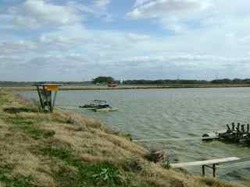
First, we need to look at aquaculture pond ecology to understand the role of AOB/NOB bacteria. In the pond, ammonia evolves from degradation of animal wastes and excess feed (especially high protein feeds). The ammonia is partially consumed by heterotrophic bacterial growth as they use ammonia as a nitrogen source to build new cells, proteins, enzymes etc. Additionally, nitrite and nitrate are used as an electron acceptor (oxygen sources) in anoxic zones in the bottom sludge. This is why ponds with deep sludge layers often have small nitrogen gas bubbles appearing in quiescent zones.
Most of the remaining nitrogen is used by beneficial eukaryotic algae. These algae uptake nitrogen and produce biomass that is consumed by the animals. Additionally, during daylight hours the algae help to oxygenate the water via photosynthesis. Algae can become a problem when prokarytoic cyanobacteria take over the photosynthetic organism niche. These organisms produce compounds that can cause off-flavor, are often associated with pH swings, and are often not as efficient at reducing ammonia/nitrite concentrations.
A healthy pond has a small background population of AOB/NOB bacteria just like the surrounding soils. This population is small because the amount of substrate (food) for the AOB/NOB populations is actually low. A wastewater tretament plant with 30 - 40 mg/L ammonia does not support an extensive population of AOB/NOB - so imaging an aquaculture pond with only 3 - 4 mg/L ammonia. Adding a concentrate of AOB/NOB may cure the problem quickly, but the population of AOB/NOB will rapidly drop to natural background levels.
An addiitional problem with AOB/NOB concentrates is their need to be refrigerated and their short shelf-life (3 - 6 months maximum). Without refrigeration, the AOB/NOB concentrate drops in activity to what you see in natural waters. So what can be done to prevent ammonia and nitrite from impacting the fish or shrimp?
- Provide aeration to keep dissolved oxygen throughout the pond
- Do not over feed or use too high a protein feed - it just becomes waste
- Before stocking - look how much sludge is in the pond. Sludge adds to ammonia, harbors opportunistic pathogens, and consumes dissolved oxygen
- Heterotrophic bacteria additions help balance the pond - they degrade sludge/wastes on the pond bottom, remove nitrite/nitrate under anoxic conditions, and uptake nitrogen to build new cells.
- Add alkalinity if necessary - we want stable pH for animals, bacteria, and beneficial algae.
My key answer is that microbial additives in aquaculture need to be started before problems arise. Using waste degrading microbes early will help with pollution related stress, disease, and keep the desired ecological blance between animal stock, waste degrading microbes and algae.

 RSS Feed
RSS Feed